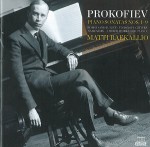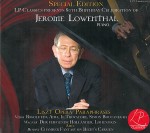Column Name
Title
Prokofiev: Piano Sonatas Nos. 1-9 and Other Works. Matti Raekallio, piano. Ondine ODE 1103-2Q
Body
With this handsomely produced four-disc set, Juilliard faculty member Matti Raekallio plunges into Prokofiev’s dazzling piano output with unbridled enthusiasm, color, and control. Raekallio’s command is immediately evident in the early Schumannesque First Sonata in F Minor (1907-09), a delicious teaser of what is to come in the later ones. By the Second Sonata in A Minor (1912), the composer had already begun to show the wit and power that most people recognize as the hallmarks of Prokofiev’s writing. In the pianist’s clear, concise liner notes, the words “sarcastic” and “explosive” describe both the works themselves and Raekallio’s realization of them. His careful rationing of pedal only increases the sensation of brittleness and energy in the composer’s waterfalls of notes.
The strange Sonata No. 5 in C Major (1923), with its delicate opening, might surprise those more familiar with the composer’s more savage output. Here the pianist engagingly shapes the composer’s fantasy world with incisive detail and rhythmic accuracy. But for many listeners the later, so-called “War Sonatas” are the zenith, and here Raekallio shows his mettle, starting with the powerful, angular Sixth (A Major, from 1939-40) and following with the staggering Eighth (1939-44) and the acidic Seventh (1939-42), both in B-flat Major. Given this ferocious trilogy, the more introverted Ninth (C Major, 1947) may come as a surprise for its change in mood; it is, as Raekallio writes, “intimate, predominantly quiet, and somewhat wistful.”
Raekallio completes his set with the impish Four Études, Op. 2—written when the composer was just 18 and in his best “Try to play that!” mode—the beefy Toccata, sinister Sarcasms, and dreamlike Visions fugitives. Slightly rarer (some collectors might want the set for this disc alone) are the ingratiating Tales of an Old Grandmother (1918) and Romeo and Juliet: 10 Pieces for Piano (1937), the latter derived from his evergreen orchestral ballet.
Engineer Robi de Godzinsky, working in the superb acoustics of Sibelius Hall in Jarvenpaa, Finland, has given Raekallio a realistic sound stage for the sonatas and Visions fugitives, with the remainder of the program adroitly captured by Enno Maemets in Sigyn Hall in Turku.
Liszt: Opera Paraphrases. Jerome Lowenthal, piano. LP Classics 1003
In honor of Juilliard faculty member Jerome Lowenthal’s 80th birthday last February, LP Classics has given him—and us—a lovely gift with this program of Liszt opera paraphrases, originally released by RCA in 1981 and until now, never released on CD. The album’s executive producers are pianists Natalia Lavrova (B.M. ’03, M.M. ’05, piano) and Vassily Primakov (B.M. ’03, piano), both of whom studied with Lowenthal at Juilliard.
The opener, the quartet from Verdi’s Rigoletto, shows Lowenthal’s artistry at its most magnificent. The pianist dispatches scales at seemingly impossible speeds while allowing melodic lines to emerge in a way that will have listeners grinning and shaking their heads, wondering how anyone can possibly maintain equilibrium when faced with Liszt’s Herculean demands. In some interpretations, these showpieces can seem gaudy—even shallow—but Lowenthal demonstrates that there’s more to appreciate here than lavish surfaces. And how he maintains control in the “Miserere” from Il Trovatore—keeping its funereal intensity from becoming a rumbling mess in the piano’s lower register—is remarkable. Additional paraphrases from Aida and Simon Boccanegra (which might be the most staggering of the four) only confirm the pianist’s ability to find the composer’s heart and soul amid torrents of notes. Walking that line between virtuosity and simplicity is one sign of superhuman pianism.
Two Wagner paraphrases, from Der fliegende Hollander and Lohengrin, will also thrill pianophiles and even die-hard opera fans might find themselves not missing the vocals. The disc includes Busoni’s Sonatina No. 6 (Chamber Fantasy on Bizet’s Carmen), recorded almost 15 years later, which becomes a heady, unusual encore. Two additional tracks, recorded live at the Music Academy of the West in 1981, are disarming introductions to Liszt’s Rigoletto. In the second version, after an audience member complained that Lowenthal’s narration would be more suited to Prokofiev’sPeter and the Wolf, the pianist obliges by combining the two in a way that would have made Victor Borge proud.
Mastering engineer Silas Brown has coordinated all this material in a way that makes perfect sense. A nice bonus is the album booklet—a short photo essay showing Lowenthal at age 12, and later with such luminaries as James Levine (Diploma ’63, orchestral conducting), Pierre Monteux, Leopold Stokowski, Maxim Shostakovich, and, in the final photo, Ursula Oppens (M.S. ’67, piano), whose adoration for the birthday boy is touchingly apparent.






